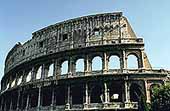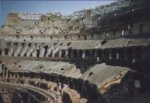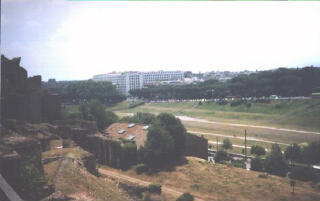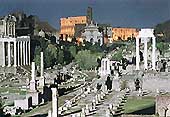
 Ancient Rome
Ancient Rome

Rome, the capital city of Italy since 1871, is a city with an incredibly
rich history. It was the main city of the vast Roman Empire, whose control
reached from Rome to places as far away as
Although partially destroyed, the Colosseum is still enormous, one of the largest Ancient Roman ruins. In A.D. 70, the emperor Vespasian began
The Circus Maximus
 The Colosseum
The Colosseum construction of the 45-50,000 seat stadium (that's larger than some baseball stadiums of today!). The building was completed in A.D. 75 and inagurated by Vespasian's son Titus. It was used for shows, mostly gladiatorial combats and wild beast hunts.
construction of the 45-50,000 seat stadium (that's larger than some baseball stadiums of today!). The building was completed in A.D. 75 and inagurated by Vespasian's son Titus. It was used for shows, mostly gladiatorial combats and wild beast hunts. The Circus Maximus was a track used primarily for horse-racing, although it was used on occasion for hunts or mock battles. It had 300,000 seats and was famous throughout the ancient world. Built in the 6th century B.C. during the time of the Tarquins, the history of the Circus Maximus is troubled. It was twice destroyed by fire and on at least two occasions the stands collapsed, killing many people. There was a long barrier (spina) that ran down the middle of the track, in the area of the picture where you now see only grass. In addition to obelisks, fountains, statues, and columns, there were also two temples on the spina, one with seven large eggs and one with seven dolphins. At the end of each lap of the seven lap race, one egg and one dolphin would be removed from each temple, to keep the spectators and the racers updated on how many laps had been completed. In the Circus Maximus, unlike the amphitheaters of the day, men and women could sit together.
The Circus Maximus was a track used primarily for horse-racing, although it was used on occasion for hunts or mock battles. It had 300,000 seats and was famous throughout the ancient world. Built in the 6th century B.C. during the time of the Tarquins, the history of the Circus Maximus is troubled. It was twice destroyed by fire and on at least two occasions the stands collapsed, killing many people. There was a long barrier (spina) that ran down the middle of the track, in the area of the picture where you now see only grass. In addition to obelisks, fountains, statues, and columns, there were also two temples on the spina, one with seven large eggs and one with seven dolphins. At the end of each lap of the seven lap race, one egg and one dolphin would be removed from each temple, to keep the spectators and the racers updated on how many laps had been completed. In the Circus Maximus, unlike the amphitheaters of the day, men and women could sit together. The Circus Maximus also had the ancient equivelant of the skyboxes you see now in stadiums for professional sports. The Emperor had a reserved seat, as did senators, knights, those who financially backed the race, those who presided over the competition, and the jury that awarded the prize to the winners. The last race held at the Circus Maximus was in 549 A.D., nearly a full millenium after the track's construction.
The Circus Maximus also had the ancient equivelant of the skyboxes you see now in stadiums for professional sports. The Emperor had a reserved seat, as did senators, knights, those who financially backed the race, those who presided over the competition, and the jury that awarded the prize to the winners. The last race held at the Circus Maximus was in 549 A.D., nearly a full millenium after the track's construction.
 Return to the Fridge door
Return to the Fridge door